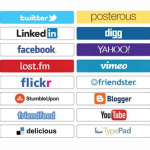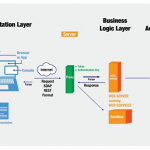API testing is different from G UI testing, but it doesn’t take long to master.
UI testing, but it doesn’t take long to master.
What is an API?
API is an acronym for Application Programming Interface. It enables communication and data exchange between two separate software systems. A software system implementing an API contains functions/subroutines which can be executed by another software system.
What is API testing?
API testing is entirely different from GUI testing and mainly concentrates on the business logic layer of the software architecture. This testing won’t concentrate on the look and feel of an application.
Instead of using standard user inputs (keyboard) and outputs, in API testing, you use software to send calls to the API, get output, and note down the system’s response.
API testing requires an application to interact with the API. In order to test an API, you will need to:
- use a testing tool to drive the API
- write your own code to test the API
Set-up of an API test environment
- API testing is different from other testing as a GUI is not available, and yet you are required to set up an initial
environment that invokes the API with a required set of parameters, and then finally examines the test result. - Hence, setting up a testing environment for API testing seems a little complex.
- A database and server should be configured as per the application requirements.
- Once installation is done, an API function should be called to check whether that API is working.
Types of output of an API
The output of an API could be:
- any type of data,
- status (say Pass or Fail),
- a call to another API function.
Let’s look at an example of each of the above types:
Any type of data
Example: An API function which add twos integer numbers.
long add(int a, int b)
The numbers have to be given as input parameters. The output should be the sum of the two integers. This output needs to be verified with the expected outcome.
Calling needs to be done such as:
add (1234, 5656)
Exceptions have to be handled if the number exceeds the integer limit.
Status (say Pass or Fail)
Consider the API functions below:
- Lock()
- Unlock()
- Delete()
Each returns a value such as true (in case of success) or false (in case of error) as output.
A more accurate test case would be, call the functions in any of the script and later check for changes either in the database or the application GUI.
Calling of another API / Event
In this case, we call one of the API functions which in turn calls another function.
For example, the first API function can be used for deleting a specified record in the table, and this function in turn calls another function to REFRESH the database.
Test Cases for API Testing:
Test cases of API testing are based on
- Return value based on input condition: Relatively easy to test, as input can be defined and results can be
authenticated. - Does not return anything: When there is no return value, behavior of API on the system to be checked.
- Trigger some other API/event/interrupt: If the output of an API triggers some event or interrupt, then those events and interrupt listeners should be tracked.
- Update data structure: Updating data structure will have some outcome or effect on the system, and that should be authenticated.
- Modify certain resources: If an API call modifies some resources, then it should be validated by accessing the
respective resources
Approach of API testing:
The following points help you with the API testing approach:
- Understand the functionality of the API program and
clearly define the scope of the program. - Apply testing techniques such as equivalence classes, boundary value analysis, and error guessing, and write test cases for the API.
- Input parameters for the API need to be planned and
defined appropriately. - Execute the test cases and compare expected and actual results.
Difference between API testing and Unit testing
What to test for in API testing
API testing should cover at least the following testing Methods, apart from usual SDLC process:
Discovery testing: The test group should manually execute the set of calls documented in the API, like verifying that a specific resource exposed by the API can be listed, created and deleted as appropriate.
Usability testing: This testing verifies whether the API is functional and user-friendly. And does the API integrate well with another platform as well?
Security testing: This testing includes what type of
authentication is required, and whether sensitive data is encrypted over HTTP or both.
Automated testing: API testing should culminate in the creation of a set of scripts or a tool that can be used to execute the API regularly.
Documentation: The test team has to make sure that the documentation is adequate and provides enough
information to interact with the API. Documentation should be a part of the final deliverable.
Best practices of API testing:
• Test cases should be grouped by test category.
• On top each test, you should include the declarations of the APIs being called.
• Parameters selection should be explicitly mentioned in the test case itself.
• Prioritize API function calls so that it will be easy for testers to test.
• Each test case should be as self-contained and independent from dependencies as possible.
• Avoid “test chaining” in your development
• Special care must be taken while handling one time call functions, like Delete, CloseWindow, etc.
• Call sequencing should be performed and well planned.
• To ensure complete test coverage, create test cases for all possible input combinations of the API.
Types of bugs that API testing detects
• Failure to handle error conditions gracefully.
• Unused flags.
• Missing or duplicate functionality.
• Reliability issues. Difficulty in connecting and getting a response from the API.
• Security issues.
• Multi-threading issues
• Performance issues. API response time is very high.
• Improper errors/warnings to caller.
• Incorrect handling of valid argument values.
• Response data not structured correctly (JSON or XML)
Tools for API testing
Since API and unit testing both target source code, similar tools can be used for testing both.
• SoapUI
• Runscope
• Postman with jetpacks
• Postman with newman
• Curl
• Cfix
• Check
• CTESK
• dotTEST
• Eclipse SDK tool- Automated API testing
Challenges of API testing
Challenges of API testing include the following:
• The main challenges in API testing are Parameter Combination, Parameter Selection, and Call Sequencing
• There is no GUI available to test the application, which makes it difficult to give input values.
• Validating and verifying the output in different system is a little difficult for testers.
• Parameters selection and categorization are required to be known to the testers.
• Exception handling function needs to be tested.
• Coding knowledge is necessary for testers.
Conclusion:
An API consists of a set of classes/functions/procedures which represent the business logic layer. If the API is not tested properly, it may cause problems not only in the API application itself, but also in the calling application.
(This article was originally published on http://www.guru99.com/api-testing.html)




















